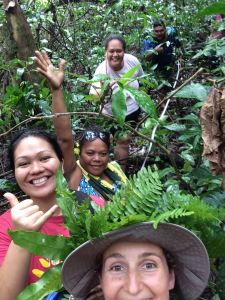Forest monitoring in the South Pacific – Blog #7
One of the best things about studying forests is that our research subjects (the trees!) are easy for other people to work with too. Measuring biomass is straight forward to explain – meaning it’s also easy to share and invite others to join in the research.

I’ve been continually amazed at how quickly volunteers, often with little scientific training, pick up the methods and run with them. And who doesn’t want to tag their own tree?!
Staff and volunteers from the Atitia Center, an educational and community outreach facility associated with Gump Station, arrived in force to assist with the establishment of a demonstration plot this week. It’s so exciting to see a new group of people embrace field research.
I also gathered up lots of new ideas as they brought their experiences and knowledge to the project. For example, Ronald made the establishment of perfectly square plots on very steep slopes look easy (surveying is his thing – he’s a builder!) Others took the lead, organising the team and making sure everyone kept focused on their tasks – it practically became a tree tagging race!
Despite getting wet, dirty, tired and having to work through the challenges of this particularly steep site, everyone returned the next day and completed the plot in record time.
On Friday we were also joined by undergraduate students from the University of French Polynesia (Université de la Polynésie française or UPF), along with their lecturer Mayalen Zubia and Jean-Yves Meyer, one of our project partners (see Forest monitoring in the South Pacific). At our early morning lecture, the UPF students mingled with the University of California Berkeley (UCB) students currently here on a field course – which led to an enthusiastic exchange of ideas and friendships.
Miriama and Heipoe then briefed the UPF students (an all girl class, what can I say, we are taking over the ecological sciences!) and they headed out to establish two new subplots at the Gump site.
We ended the day with a walk along the Ara tupuna (path of the ancestors) trail in the Opunohu Valley with Jean-Yves stopping regularly to share bite sized factoids about the plants and habitats around us. Everyone was enthralled. We learnt about the plants introduced by early Polynesian explorers and their uses, as well as the clever spiral arrangement of the leaves on a ginger plant – designed to maximise the capture of light below the canopy.
Mayalen is keen for her class to return each year to learn how to monitor the forest plots. This will be a fantastic opportunity to track how the forest grows and changes, and to inspire future students in tropical forest ecology!
UPDATE: Mayalen Zubia has written a great article about the day on the Université de la Polynésie française website.

















You must be logged in to post a comment.